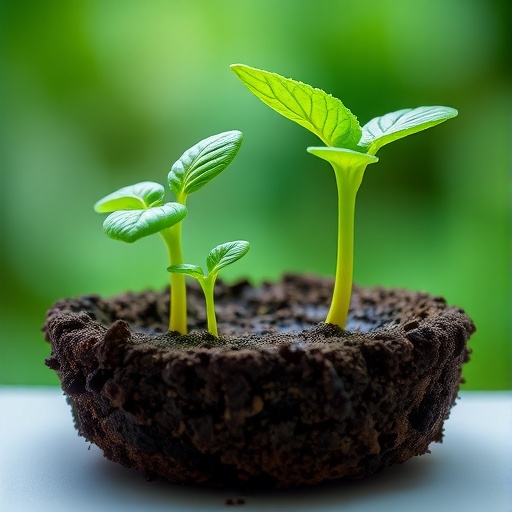
Recent advancements in agricultural biotechnologies have opened the door to revolutionary practices that could fundamentally alter how we approach crop fertilization. One of the most promising discoveries in this area comes from the research conducted by Srinivasan and colleagues, who identified a specific endophyte, Microbacterium thalassium VALIDK02, found in Capsicum frutescens, commonly known as chili pepper. This microorganism demonstrates remarkable capabilities in producing indole-3-acetic acid (IAA), a phytohormone that plays a crucial role in plant growth and development.
The significance of IAA cannot be overstated, as it is an essential auxin that regulates various aspects of plant reproduction, including cell division, elongation, and differentiation. By harnessing the power of Microbacterium thalassium VALIDK02, researchers are optimistically looking towards sustainable agricultural yields without the over-reliance on chemical fertilizers that have long troubled the environmental landscape. The ability of this endophyte to produce IAA suggests a natural method of enhancing nutrient uptake in plants, which could lead to a more sustainable approach in the cultivation of crops.
The isolation of Microbacterium thalassium VALIDK02 marks an important step forward in biotechnological applications for agriculture. Found within the tissues of the Capsicum frutescens plant, this endophyte works in a synergetic relationship with its host, contributing to its growth and defense mechanisms. This relationship underscores the potential symbiosis between beneficial microorganisms and plant species, which could facilitate improved fertility and resilience against environmental stressors.
In light of increasing global population pressures and the ensuing demand for food production, finding innovative solutions that enhance plant growth efficiency is paramount. Microbacterium thalassium VALIDK02 presents a natural solution that not only boosts plant growth but could potentially lower production costs incurred by synthetic fertilizers. Thereby, farmers adopting biofertilizers based on this endophyte could experience enhanced productivity while enjoying the benefits of environmentally friendly practices.
Furthermore, the implications of harnessing such microorganisms extend beyond mere biofertilizers. Endophytes like Microbacterium thalassium VALIDK02 could gradually revolutionize not just the way we fertilize but also support traditional agriculture by promoting ecosystems rich in biodiversity. This could lead to healthier soil, improved crop resilience, and robust food systems that can withstand climate variations—ensuring food security for generations to come.
Interestingly, this research shines a light on the broader aspects of microbial ecology and resonates with the ongoing discourse on the microbiome’s role in facilitating plant health. Just as gut microbiota influence human health, beneficial endophytes enrich plant health, suggesting that a comprehensive understanding of microbial populations is vital for agricultural innovation.
As we delve deeper into this groundbreaking research, it’s worth noting that Microbacterium thalassium VALIDK02 is only one example among a myriad of microorganisms possessing potential agricultural applications. Thus, the study encourages further exploration into the extensive microbial diversity that could yield other beneficial traits and capabilities, pushing the boundaries of what is traditionally considered possible in agriculture.
The transformative potential of Microbacterium thalassium extends into organic farming practices, where chemical fertilizers are routinely avoided. As consumers become increasingly aware of their food sources and the ecological footprints of agricultural practices, biofertilizers such as those produced from this endophyte could not only satisfy market demand but also align with sustainable consumer behavior.
Moreover, the foundational research conducted by Srinivasan et al. emphasizes the role of scientific investigation in bridging the gap between fundamental knowledge and practical applications. The meticulous documentation of the endophyte’s characteristics, IAA production, and corresponding agricultural enhancements exemplifies the transformative potential of collaborative scientific inquiry. In a world challenged by climate change, population growth, and natural resource depletion, such research serves as a beacon indicating that viable and innovative solutions are within reach.
With the promise of increased crop yields and reduced reliance on harmful chemicals, Microbacterium thalassium VALIDK02 represents a significant leap towards sustainable agriculture. Naturally, adopting these new biofertilization methods could enhance food quality and mitigate the practices traditionally linked with ecological damage.
Looking forward, this study suggests that widespread integration of endophyte-based fertilizers may not just be a possibility but a necessity if agriculture is to adapt to future challenges. As more findings emerge, a roadmap towards comprehensive biotechnological solutions could very well become the cornerstone of agricultural advancements. In conclusion, the exploration of Microbacterium thalassium VALIDK02 illuminates the vast potentials locked within microbial communities, heralding a new era of harmonious coexistence between humanity and nature aimed at fostering sustainable agricultural practices.
Subject of Research: Microbacterium thalassium VALIDK02 as a biofertilizer
Article Title: Microbacterium thalassium VALIDK02: an indole-3-acetic-acid producing endophyte of Capsicum frutescens as a promising biofertilizer for agricultural applications.
Article References:
Srinivasan, D., Girish, V., Kumbipalya Narayan, V.S. et al. Microbacterium thalassium VALIDK02: an indole-3-acetic-acid producing endophyte of Capsicum frutescens as a promising biofertilizer for agricultural applications. Discov. Plants 2, 259 (2025). https://doi.org/10.1007/s44372-025-00344-8
Image Credits: AI Generated
DOI: 10.1007/s44372-025-00344-8
Keywords: Microbacterium thalassium, biofertilizer, indole-3-acetic acid, endophyte, sustainable agriculture.
Tags: agricultural biotechnology advancementsauxin regulation in plantsCapsicum frutescens endophyteseco-friendly crop fertilization methodsindole-3-acetic acid productioninnovative farming techniquesMicrobacterium thalassium biofertilizermicrobial solutions for farmingnatural plant growth enhancementnutrient uptake improvementresearch on beneficial microorganismssustainable agriculture practices




